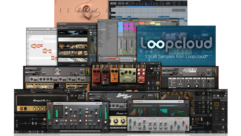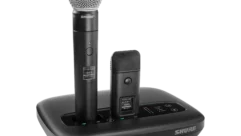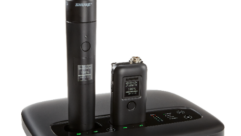In this edition of the SVC Podcast, Contributing Editor Bennett Liles continues his conversation with Murvin Persaud of MD Audio and Raphael Narine of New York’s Paramount Events. This time they switch gears to the recent ECLIPS Music Festival in Queens where Powersoft amplifiers from MD Audio and the setup along with the setup and mixing by Paramount Events offered a good time for the show’s huge audience.
Links of Interest:
- MD Audio on Facebook
- New York’s Paramount Events on Facebook
- D&b Audiotechnik M2 Monitors used onstage at the ECLIPS Music Festival
- Yamaha CL5 Mixer used on the ECLIPS Music Fesival
Download Podcast Here:
https://s3.amazonaws.com/nb-svc/public/public/188-2_Calgary_and_ECLIPS_N…
This is the SVC Podcast from Sound & Video Contractor Magazine with Murvin Persaud of MD Audio and Rafael Narine of Paramount Events. Show notes and product links for this and other SVC podcasts are at svconline.com.
Fixed installations are one thing but the gear can really take a beating on the road at outdoor events. Rafael Narine of Paramount Events and Murvin Persaud of MD Audio got together to equip and run the recent ECLIPS Music Festival in Jamaica, New York and they’re both back to tell us how they got it done with Powersoft amps. That’s right now on the SVC Podcast.
Murvin and Rafael, thanks for being back with us for Part 2. Last week we were talking about the Calgary Assembly of God installation and this week we completely switch gears to cover the recent ECLIPS Music Festival. It gets a little more challenging with a big crowd and a huge variety of music acts onstage, right out in the open. Rafael, where was that held? I think it was in Queens, right?
Rafael: Yes, that was held in Queens in a park called Roy Williams Park. That park hosts a lot of large-scale events throughout the year and the entire summer. We’ve done quite a few events in that park over the years. This one in particular was a little special. We were doing it a little differently. We were a little bigger scale-wise; more audio, more lights, more video, more everything. All of that, it’s not unfamiliar to us, so we had no problems pulling it off. [Timestamp: 1:41]
And Murvin, I know they used the Powersoft amps for this but you were transitioning some of your equipment from other amps over to Powersoft to save some power and make your racks run cooler.
Murvin: Yes. Well, Ralph actually started to get into the Powersoft so he’s getting rid of some of the old stuff and replacing with Powersoft amplifiers right now. [Timestamp: 2:00]
So how much advance time did you have to set up for the festival? I would think that an event like that would be pretty tight on the setup time.
Rafael: Yeah. You know what? I made an arrangement with the promoters and the event planner that we need an adequate amount of time to get it done. We started about three days ahead of schedule. The show was on a Sunday, but we started on the Thursday – the morning. The stage came in and we started building. It came in from a company in Pennsylvania, Mountain Stage – a pretty big company. We hauled in about 44 or 46 line arrays in large format EV Xvls and Xvlt. Those are dual 15’s so they’re quite robust. We had to do some serious coverage, about 600-800 feet – that was the throw – so just to give you an idea. [Timestamp: 2:50]
Yeah.
Rafael: And then we had about 46 subs; double 18’s and double 21’s.
And did you do the mixing on that or just do the setup?
Rafael: Well, I handle everything. My company, we did the entire install. We did all of the mixing, except when you had a – some of the acts with their own front-of-house engineer. But for the first 15-20 performances, we did that. No problem. [Timestamp: 3:16]
And how was it doing the front of house mix on this thing with so many different acts onstage even though some of them had their own sound people? I would think that it would get a little dicey just figuring out what they’re going to do next.
Rafael: We had a little sound check before, but when you do this for a living and you understand what to expect, it becomes much easier because we all have an agreement – all the engineers and everyone. It’s a festival and you have to do a festival mix. Meaning it has to be set up in a way that you’ve got to tolerate what the other guy was doing to a certain extent. And keep in mind that you have to let go of what you’re trying to do because there’s another act coming up after you and you have to be able to transition flawlessly or seamlessly without having an issue of oh, now we’ve got to go rebuild the entire mix we had before. So during festivals, unless you have an extra console sitting there for every major act, if you’re using the same console you have to give the chance so the other guy that’s going to come up next to you or after you – so everyone has to be in harmony with what has to get done. [Timestamp: 4:20]
And Murvin, when you’re providing this equipment for the ECLIPS Festival and other events, do you see a lot of people coming in an taking lots more stuff than they need just to have a lot of backup gear just in case?
Murvin: Well, Ralph has about enough to do with whatever he needs to get done. Basically he’s got a lot of headroom to work with. He runs multiple amps. I can’t remember how much exactly, but he can conform. But he had a few racks of Powersoft amplifiers there and some of them actually came from me. [Timestamp: 4:51]
And in addition to setting up the amps Rafael, you have to get the mic signals from the stage to the mixer.
Rafael: We used those Yamaha CL5’s front of house and stage monitor mix, but we networked them together with the Rio stage boxes; 48 channels. And then we had 24 returns from the front of house and the stage, but I had everything run directly to the DiGiCo console and had that run the entire system as far as front fill, delay, side fills, subs. Everything was managed from that mixer. So that alleviated any stress from the front of house engineer trying to control the PA at the same time. So we kind of did it that way to keep to separate because we know what’s going to happen is you’re going to have four or five engineers coming up to the console for their artist and they won’t have the ability to tell them what to do: “Hey, listen. I need more side fills,” or “Hey, I need more front fills.” So we took that away from them. Just focus on your mix and we’ll focus on the PA and that was it. So there was no interruptions in that sense. [Timestamp: 5:54]
At the ECLIPS Festival do they primarily use floor monitors or IEMs?
Rafael: Well, there was a combination of IEMs and floor wedges. We used the D&B M2, I want to say – those were the dual 12’s from d&b – but we didn’t use the Powersoft amps. It actually came with its own amplifiers from d&b, which we had no control over, which was how their monitors were built. But, we did use the Powersoft system on the PA, which was fine. It ran the entire day flawlessly. No issues, nothing shutting down, nothing blown, nothing. So that’s a plus. [Timestamp: 6:27]
I guess that and making sure that all the wireless gear works and there’s no frequency coordination problem.
Rafael: With the wireless situation there’s a lot of issues in certain places, but when you’re out of the Manhattan/Times Square area, it seems to be a lot easier because what happens is in Times Square you have a lot of – you have Broadway. And they have about 20 or so studios; a couple of hundred wireless packs. And the airways are just crowded. Everyone needs a space. So that’s the issue, but in the situation where we were, in the park, it was easy; not much interruption. Yes, the airport is right there, but we were good. We were fine. There was no unexpected issues. You just check it out with your local airways, the regulation, and we were fine. [Timestamp: 7:13]
And Murvin, what have you got coming up right now? Have got some big projects coming up on the equipment side of it for installations or for road gear?
Murvin: Well, I have something in order, some Powersoft amplifiers – and those are not the permanent install ones. Those are touring amps. So waiting for those orders to come through. They’re actually big orders and some of them are for the United States, some are for export. Basically MD Audio does both. We sell in and out of the United States. [Timestamp: 7:45]
And Rafael, for Paramount Events, what have you got looming ahead?
Rafael: Well, I have a few orders I have to make with Murvin because I had a couple of installs come in in the past two weeks. And I told some of the manufacturers of line arrays and such that I’m only using Powersoft amps and if you cannot allow me to do that then I can’t use your product. And now they’re working out ways and means to allow me to do so because I like the amps. I like how they work and they do what I need. And now that these manufacturers are understanding, hey listen, this guy knows what he’s doing. He’s got to get what he needs and we’ve got to do it. You want to make the sales you’ve got to deal with it. And that’s the message I’m giving them. Listen, if you can match these numbers up, fine, but they can’t. So they have to work with me. And Murvin knows. And I tell him some of the stories and I show him some of the emails and some of the discussions about what happens. So when you look at the numbers it’s a no-brainer. Powersoft definitely wins. [Timestamp: 8:40]
I’m sure you were glad to have them at the church for the installation there and then at the ECLIPS Music Festival with everything that was going on. Good of you both to tell us how you worked on these projects and got them done. Murvin Persaud, owner of MD Audio.
Murvin: Well, MD stands for Murvin Danny Persaud. That’s where the MD Audio came from. So some guys know me by my middle name, some know me by my first name, but MD Audio, that’s what it stands for. [Timestamp: 9:03]
Well, that keeps it covered then.
Murvin: Yes. Mm-hmm.
Rafael Narine, CEO of Paramount Events in New York, always busy. And again thank you both for taking time out to tell us about these projects.
Murvin: Thank you.
Rafael: Sure. There will be more along the way. You’ll hear about them.
Sounds good. Looking forward to it.
Glad you made it back with us for Murvin Persaud of MD Audio and Rafael Narine of Paramount Events. All of the show notes and AV gear links for today’s talk are right here on the website of Sound & Video Contractor Magazine at svconline.com. Let’s get back together again next week for the SVC Podcast.










